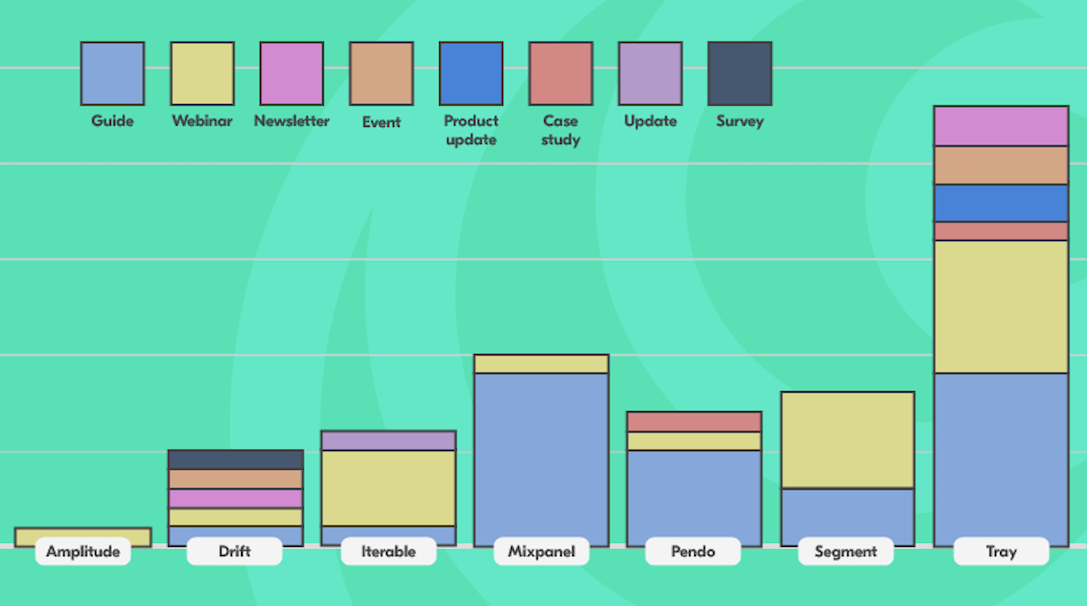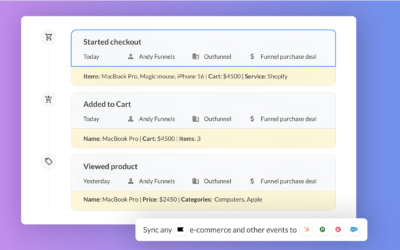Recently, 10 martech firms came together, spearheading the “CRM Is Not Enough” movement.
This post is less about this “declaration” but more about email best practices. A somewhat-subjective (OK, a lot subjective) and somewhat-scientific email marketing teardown.
You see, when I added my name to the launch webinar I opted in for receiving marketing messages of the companies behind the declaration. All of these companies got my details at the same time, through the same channel. I may have been on email lists of some of these companies previously too, but even so, my observations and conclusions hold.
The list included the likes of Drift, Amplitude, Iterable and Segment. These companies are not on the cutting edge of growth marketing, they are the cutting edge. So I was quite excited to be learning from the very best. (Spoiler alert: even the very best make mistakes and miss opportunities, so we can all relax).
Before starting this post-event email marketing teardown though, I want to apologise.
To all the marketers out there. People at Amplitude, Drift, Iterable, Mixpanel, Pendo, Segment, and Tray:
I’m sorry for repeatedly clicking on email links (like, a lot) and probably setting off some sort of alarm in your marketing analytics platform (probably Marketo; more on that later).
I broke down this marketing email teardown into 9 sections, all focused on different areas.
Here’s what I analyzed:
- Marketing-to-sales flow
- Content
- Subject line
- Design
- Call-to-action
- Frequency
- Personalization
- Email service provider
- UTM tracking setup
I looked at 69 emails from 7 companies (mentioned above), across 99 days between 16/01/2020 and 24/04/2020. The volume of emails isn’t really enough to make sweeping statements about the overall state of email marketing. That said, there are still some interesting insights to glean from the numbers.
And of course, in the absence of data, there’s always opinion..
If you don’t fancy sticking around for the whole thing, that’s fine. I’ve included a tl;dr at the bottom for the time impoverished.
So, it’s time to glove up and dive in.
Marketing vs Sales: how many emails from each?
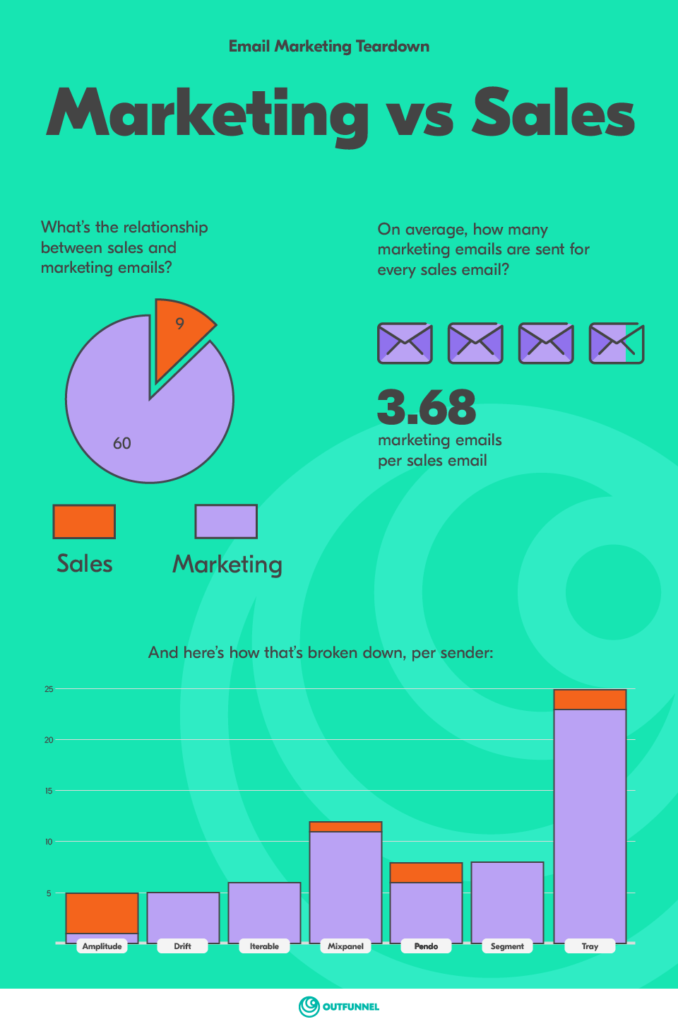
Outfunnel’s goal is to bring sales and marketing closer together, so the first thing I wanted to look at is how these titans of the martech ecosystem move leads along the marketing funnel and sales pipeline.
A handful of companies (Drift, Iterable, and Segment) didn’t grace my inbox with any sales emails at all. Everyone else did reach out with some sort of sales-focused message, though. Without seeing behind-the-scenes, it’s hard to tell whether those not sending emails are simply not sending them, or maybe I never triggered them by performing some kind of “high intent” signal action along the way.
There’s a couple of things that stand out to me here.
Firstly: Tray. They really seem to have the marketing flow dialled in. With what looks like a core drip campaign, kicking in after the initial post-event series I received. There’s definitely a “carpet bombing” element going on with Tray (more on email frequency later though), but I can’t help but admire the effort going into it.
Another thing about Tray was that the two core campaigns I mentioned above seemed to have a clear marketing to sales flow defined and, in the case of the second, they really marketed hard. Tray’s “main” drip campaign consisted of 10 emails total, with one of those being a sales email.
At the other end of the spectrum was Amplitude. Amplitude actually sent more sales-focused emails (4) than marketing emails (1). I’m kind of on the fence about this approach.
In my view, a lead landing in your lap from an event list isn’t going to be as hot as, say, someone signing up for something on your website. It’s a pretty low intent signal, to be honest. Going all-out with sales emails, without spending some time making sure I know what they’re all about seems like a wasted opportunity.
Plus, two of the sales emails from Amplitude consisted of one sales offer (yay!) and one apology email for sending me the sales offer in error (boo! but also yay for reaching out with a clarification).
Across the whole “experiment”, I received around 4 marketing emails for every sales email.
So, how did they all try and move me along the pipeline? What kind of content did they use to nurture me? What’s the most common sales approach?
Let’s take a look at the content.
What type of content do the very best use in emails
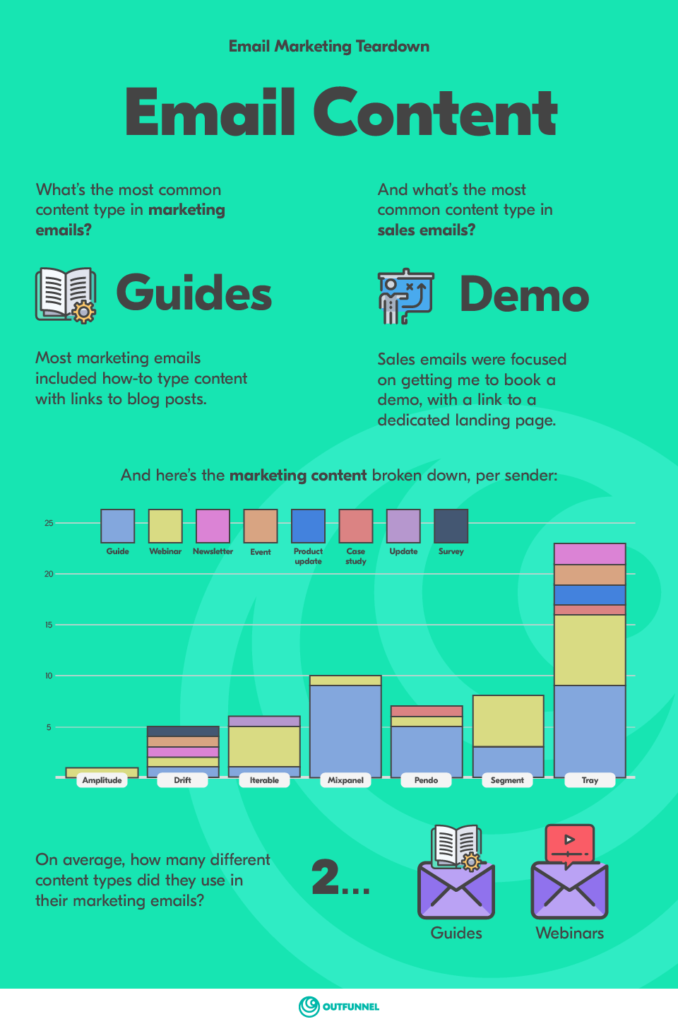
It’s not entirely surprising that “guides” were the most common type of content marketers were using to nurture me along their respective pipelines. These guides ranged from broad “what is x” type of things right through to specific, actionable how-to’s.
Also, perhaps unsurprisingly, most of these emails linked to blog posts. The email itself being a kind of teaser for the main event on the blog.
Again, hardly an earth-shattering revelation.
A highly unscientific look at the publication info on a handful of these posts points to most of them being older posts, hand-picked for the purposes of lead nurturing.
This makes a lot of sense. Even a cursory glance at Google Analytics should be enough to make you go “hey, these posts are converting search traffic, let’s send these articles to our email subscribers”. Then it’s just a case of packaging them up into an email marketing sequence.
A couple of things that did standout though were how reliant marketers are on video in 2020. A good chunk of these guide emails linked to YouTube or Wistia. It wasn’t just premade video content in email though: webinars by themselves came a very close second behind guide-type content.
Tray even had a weekly demo webinar session, in addition to their core drip campaign.
There were a couple of companies recycling emails, with Mixpanel almost literally sending the same email twice (even with the same subject lines). This kind of makes sense if they are sending ad hoc emails. Want to squeeze a few more opens out of your email? Segment people who didn’t open it the first time around and resend it to them.
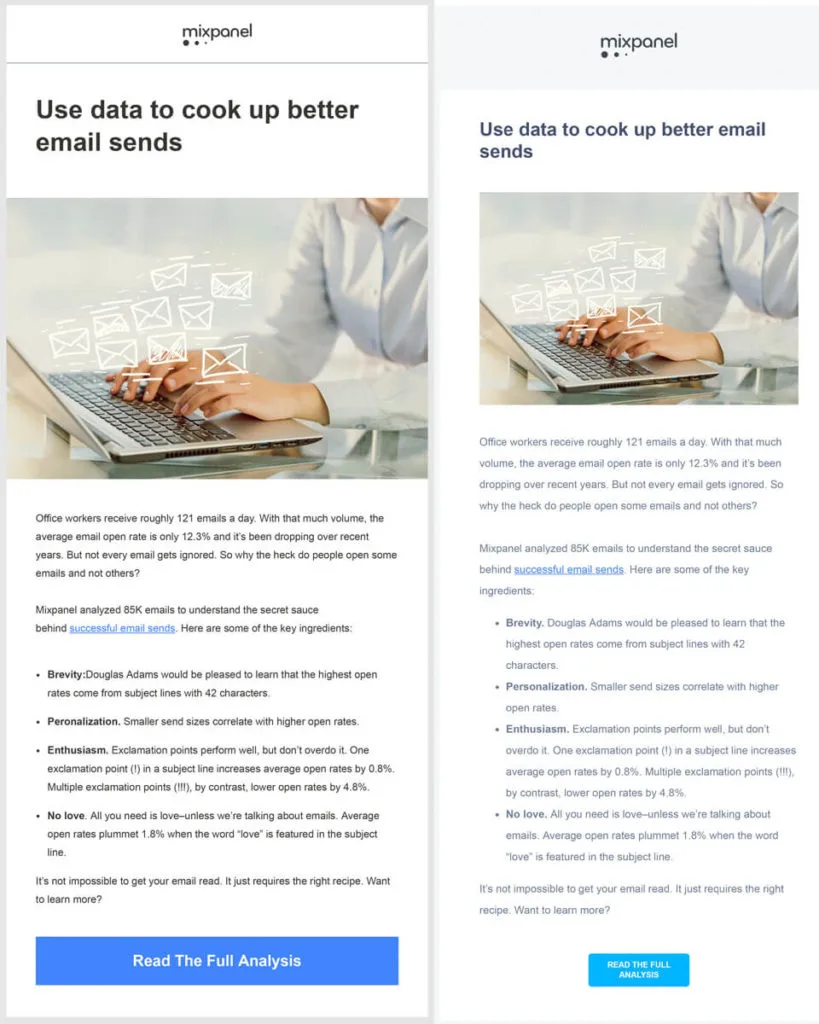
There was also at least one instance of a company literally sending me the same email twice, on the same day, within an hour of each other.
Unlike the Mixpanel emails, there was no difference in design. Literally the exact same message. The only difference I could spot between them though was that one had a personalized from and reply to address, the other used general info here.
My guess is that it was an error.
Even the biggest names in the business screw up, just like the rest of us.
A look at subject lines (it’s all very subjective)
Marketers spend a lot of time analyzing and debating subject lines. After all, they carry a lot on their shoulders. Your email might be polished, the landing page or post might be a shining beacon of marketing excellence.
But all of that is for nought if the subject line is garbage. Even “ok” isn’t really good enough.
Scrutinizing email subject lines is probably worth a post on its own, so I will keep my analysis brief, highly subjective, and mildly scientific.
Looking at averages, character and word counts across all 69 emails were around 40 characters and 8 words.
As this isn’t a scientific experiment, I here are a few subjectively selected subject lines that stuck out to me, for the right and wrong reasons:
How to stay connected and keep the convos going (virtually) – Nice, conversational style. Gives me enough of a hint about what to expect, setting my expectations, but leaves enough unsaid to trigger some interest.
CRM is Not Enough – thoughts? – Not a fan of just using “thoughts” in emails – either in the subject line or when signing off. It’s a lazy, fuzzy call-to-action. You want my actual thoughts? Stop using “thoughts?”.
Don’t be like New Coke – I’m on the fence about this one. It triggered the “hmmmm” part of my brain for a couple of milliseconds longer than the majority of the other subject lines, but it’s maybe a little on the creatively abstract side because it doesn’t give me any idea what to expect on the other side. You may get more opens, sure, but perhaps not by the people you wanted to reach in the first place.
Andrus – We missed you – One of, quite literally, 3 emails that actually used my name in the subject line. Maybe they all have some data that says it makes no difference? Maybe that’s something for some deeper analysis in the future? One thing’s for sure, I was surprised to see so few marketers using personalization in their subject lines.
Not another Covid19 email – Please, stop. You’ve used the c-word in the subject line, thereby making your email about the c-word.
Generally speaking, Drift was one of the companies that stood out here. They were the only one to use emojis in their subject lines and also the only ones to go for an all lower-case subject line. This matched well with the overall tone of their emails: they felt kind of conversational and laid back.
Email design: critique from a Grumpy Martech CEO
Across the board, the marketing emails were very design heavy. The exceptions here were Drift and Segment, sticking with a much more low-key, personal-feeling approach, something we’re fans of at Outfunnel. Sales emails though were much less reliant on design.
I have some mixed feelings on this topic, particularly the use of large header images at the top of marketing emails.
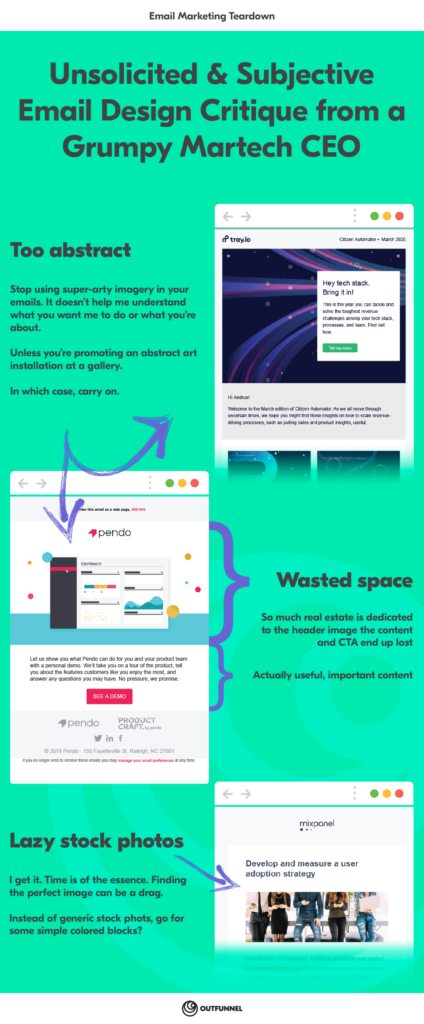
You see, for me, sticking a big image at the top sort of feels like it has become the de facto choice for marketers. Got to get that image in there. Got to define the brand.
But the problem is two-fold.
From a practical perspective, it pushes the content further down the email, particularly on mobile. So you’re asking your reader to scroll further in order to reach the thing you want them to read/click.
The second problem is a function of the first: in all probability, you want them to scroll past the image. So, if that’s the case, why have the image at all? I can see an argument for visuals that set a tone, or are part of some visual messaging. Marketers want things to be cohesive between emails, landing pages, posts.

But just sticking a stock photo of people waving their pens at a laptop? That’s a pass from me.
Call-to-action: it pays to have one
Although a lot of the call-to-actions in these emails jumped out as the “main” CTA, there were many emails with multiple big buttons all vying for my attention. Similarly, there were also lots of emails where nothing really stood out as the main CTA.
So, for this section I focused on the CTA’s that, subjectively, grabbed my eye first. The ones that made me feel “ok, this is what they want me to do”.
And to further simplify the process, I bundled the CTA’s into 3 main groups: button, text link or image.
Every one of the marketing emails I received during the 99 day window had some sort of call-to-action. So, a good start there.
And as the majority of these marketing emails were heavily designed, it doesn’t come as a shock that buttons-based CTAs were the most common.
Buttons were also the most common CTA type used in sales emails, but text-based CTAs were, relatively speaking, more common here. It was also interesting to note that at least one of the companies sent a sales email with absolutely no clear CTA at all.
Personally, I would include something. Sending “just checking in” or “thoughts?” type sales emails come across as lazy in my view. It’s just more email noise.
Subjectively, there wasn’t anything that leapt out at me as being earth-shatteringly creative with any of the CTAs. For both the marketing and sales email CTAs the emphasis seems to be on clarity rather than creativity.
And maybe that’s the point. If you want your recipients to do a thing, most sure it’s absolutely clear what it is you’re asking them to do.
Frequency: more is not better
Email marketing spam sucks.
In my view it really is one of those areas where “less is more”. People’s inboxes are already being flooded with sales and marketing messages and adding to that, in my view, just makes you part of the problem.
In my view, one marketing email every two weeks is a pretty balanced level. You’re not being spammy and at the same time you’re making sure your customers know you still exist. And it seems a lot of these companies agree with this.
Very approximately, all of the companies sent me a marketing or sales email once every 2-3 weeks. Granted, that calculation is kind of skewed, because as I mentioned above there were some instances where I was receiving two emails within a matter of hours.
But, generally speaking, the average came to around 1 email every 2 weeks.
All with one exception: Tray.
In their case, they were sending me more than one email per week. The sheer volume of different campaigns (looking at the utm tracking, more on that shortly) is certainly impressive. I mean, they’re clearly putting a lot of effort in.
But I can’t help but feel that by toning it down, ever so slightly, I might feel less like I’ve been psychologically beaten into submission. Having all of these different campaigns happening at the same time gives the impression that there are so many moving parts but those parts are siloed from one another.
Again, kudos for the effort, Tray. But less really can be more.
Surprisingly little personalization
This is one area that kind of caught me by surprise if I am being honest.
You see, as marketers we ask for various bits of personal info from people. That may be basic info so we can contact them, or more detailed stuff, like company size and industry, in order to more accurately qualify leads.
But almost every time, we’ll ask for a name.
So, why not use it?
Less than half of these emails used any personalization at all and those that did only went as far as a simple “Hello Andrus”. Only a handful of emails used my name in the subject line.
Granted, there are plenty of things that may be going on behind the scenes in terms of personalization. I may be in a specific funnel, based on the information they have on me, for example.
I’m a believer in human, conversational marketing (no, not chatbots) and addressing me by name, maybe even dropping in my company name, makes it feel less like I am not receiving a standardised generic email and more something that was made for me.
The same email marketing platform used by all
Although this email marketing teardown isn’t some sort of competition, if it was there is one, clear winner:
Marketo.
It’s difficult to know exactly what marketing automation tools are being used without really, really digging into it, but looking at things like unsubscribe pages and tracking info, Marketo was the one name that came up again and again.
And how many companies were using Marketo at least somewhere in their email marketing stack?
Every. Single. One.
Granted, this sample size is pretty miniscule, but I was still struck by how ubiquitous Marketo has become for mid-market tech companies of certain size.
By the way, if you’re not a mid-market tech company and are looking for an email marketing tool, check out Outfunnel. Our unique selling point is tight integration with sales tools like Pipedrive and Copper
UTM tracking: many rely on tagging by their email platform
In email marketing (or any digital marketing, really) adding UTM tracking to links should eventually become second nature to most.
As every single company I looked at uses Marketo, all of the tracking should be handled there (I checked at least one link in every email and, yes, there was at least one of the marketo tracking tokens added to the link).
But there are a couple, namely Mixpanel and Tray, that went “belt and braces”, choosing to include UTM tracking as well. In Tray’s case it was actually pretty revealing, because it showed just how many different campaigns they were sending as well as how many emails went into each campaign.
| Source | Medium | Campaign | Content |
|---|---|---|---|
| marketo | nurture-me-marketing-2019 | weekly-demo | |
| internal | weekly-demo-email | weekly-demo | |
| marketo | nurture-me-marketing-2019 | blog | |
| tray | rev-growth-2020 | – | |
| internal | weekly-demo-email | weekly-demo | |
| marketo | nurture-me-marketing-2019 | blog | |
| – | – | – | |
| internal | weekly-demo-email | weekly-demo | |
| marketo | nurture-me-marketing-2019 | blog | |
| tray | celebrate-online | – | |
| internal | weekly-demo-email | weekly-demo | |
| marketo | nurture-me-marketing-2019 | blog | |
| marketo | nurture-me-marketing-2019 | blog | |
| marketo | newsletter | blog | |
| marketo | nurture-me-marketing-2019 | blog | |
| marketo | nurture-me-marketing-2019 | blog | |
| marketo | productupdate | blog | |
| marketo | nurture-me-marketing-2019 | blog | |
| internal | weekly-demo-email | weekly-demo | |
| marketo | nurture-me-marketing-2019 | blog | |
| marketo | newsletter | blog | |
| marketo | webinar-real-world-revops | webinar | |
| internal | recorded-demo-multi-confirm | demo | |
| partner | crm-not-enough | tray-followup |
Does this signify the death of UTM tracking in marketing and sales emails?
Well, no. Again, this sample size is pretty small, so I am not going to draw any sweeping conclusions from it.
What does surprise me is that more companies aren’t using both Marketo and UTM tracking in combination. If you have the option, it’s almost always better to have two sources of data, so that you can compare them against one another and, potentially, spot issues in one platform or the other.
Email marketing teardown: In summary (tl;dr)
- Marketing-to-sales flow – most marketers are using around 4 marketing emails to warm up leads before sales steps in. One standout was Tray: their main lead nurture campaign featured 9 nurture emails before I got a sales email.
- Content – most marketers like to combine different types of content in their emails, usually using 2 different content types. The most popular content types were guides (how-to’s and things like that) and webinars.
- Subject line – The average word count for subject lines was 8. Drift stood out here, thanks to their use of emojis and all-lowercase text in the subject lines.
- Design – Most marketers are using heavily designed emails, but there’s still room for the less designed, more personal-feeling style, with Segment and Drift using these to great effect.
- Call-to-action – All of the marketing emails had at least one CTA, with buttons being most common. CTAs were common in sales emails too, but there were a handful missing any call to action.
- Frequency – Overall, marketers were sending 1 email every 2 weeks or so. With the exception of Tray who went all out, sending multiple marketing emails per week throughout the whole analysis period.
- Personalization – Personalization in the email content was widely underused, with <50% of marketers using any personalization, and those that did only went with a “Hello Andrus”. A couple of marketers used some personalization in the subject line.
- Email service provider – Marketo was the one name that came up over and over. Every single company I looked at had Marketo somewhere in their email marketing tech stack.
- UTM tracking setup – Because everyone is using Marketo, a lot of marketers have ignored traditional UTM tracking in their emails, with the exception of Tray and Mixpanel.
It was certainly an enlightening process, going through all of these marketing emails. If I was to do another email marketing teardown, I might focus on one, specific area and analyze a larger pool of companies over a longer period, perhaps.
Thoughts?
PS. Massive thanks to Ben Billson who provided lots of useful feedback and suggestions to this post. I warmly recommend him for content work.

